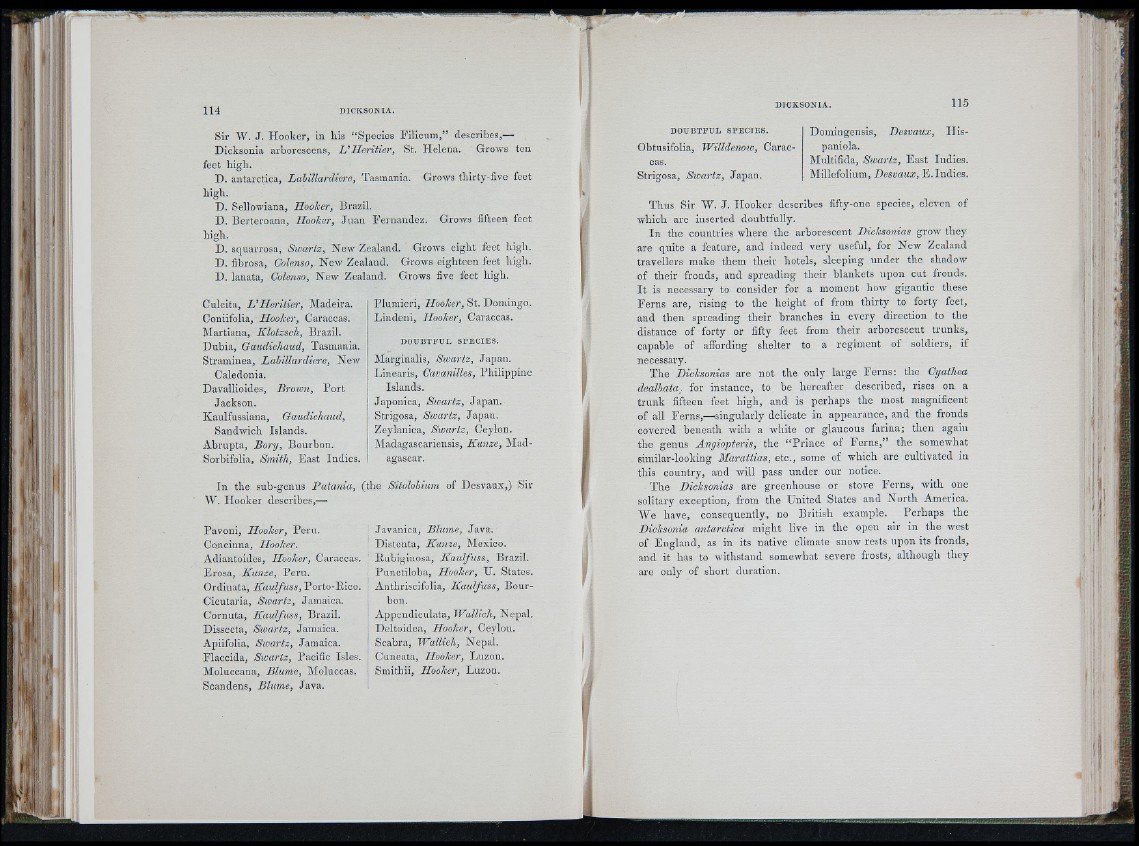
l i! '
,11 Ssii
Sir W . J. H o o k e r, in his “ Species F ilic um ,” describes,—
Dicksonia arborescens, U H e r itie r , St. H e len a . Grows ten
feet high.
D . antárctica, L ahillardiere, Tasmania. Grows thirty-five feet
h igh.
D . Sellowiana, Hooker, Brazil.
D . Be rte ro an a , Hooker, Ju a n Fe rn an d e z . Grows fifteen feet
high.
D . squa rrosa, Sw a r tz, N ew Zealand. Grows eight feet high.
D . fibrosa, Colenso, N ew Zealand. Grows eighteen feet high.
D . lanata, Colenso, N ew Zealand. Grows five feet high.
Culcita, L ’H e r itie r , Madeira.
Coniifolia, Hooker, Caraccas.
Ma rtian a , K lo tz sch , Brazil.
D u b ia , Oaudichaud, Tasmania.
Straminea , Lahilla rd ie re , New
Caledonia.
Davallioides, B roten, P o rt
Jackson.
K aulfussiana, Gaudichaud,
Sandwich Islands.
A b ru p ta , B ortj, Bourbon.
Sorbifolia, Sm ith , E a s t In d ie s.
P lum ie ri, Hooker, St. Domingo.
L in d e n i, Hooker, Caraccas.
D O U B T F U L S P E C IE S .
Marglnalis, Sw a r tz, Japan.
L ine aris, Cavanilles, P h ilip p in e
Islands.
Japonica, Sw a r tz, Jap an .
Strigosa, Sw a r tz, Jap an .
Zeylanica, Sw a r tz, Ceylon.
jMadagascariensis, K u n z e , M a d agascar.
I n the sub-genus P a ta n ia , (th e Sitolohium of D e sv au x ,) Sir
W . H o o k e r describes,—
[ ¡ T f
11 li?
P av o n i, Hooker, P e ru .
Concinna, Hooker.
Adiantoides, Hooker, Caraccas.
E ro sa , K u n z e , P e ru .
Ordinata, K a u lfu s s , Porto -E ico .
Cicutaria, Stoartz, Jamaica.
C o rn u ta , K a u lfu s s , Brazil.
Dissecta, Sw a r tz, Jamaica.
ApiifoHa, Sw a r tz, Jamaica.
F la c c id a , Sw a r tz, Pacific Isles.
Moluccana, B lum e , Moluccas.
Scandens, B lum e , Java.
Javanica, B lum e , Java.
D isten ta , K u n z e , Mexico.
E u b ig in o sa , K a u lfu s s , Brazil.
; P u n c tilo b a , Hooker, IT. States.
Anthriscifolia, K a u lfu s s , B o u rbon.
App en d icu la ta , W a llich , N ep a l.
D eltoidea, Hooker, Ceylon.
Scabra, W a llich , Nepal,
i Cune ata, Hooker, Luzon.
! Smithii, Hooker, Luzon.
D O U B T F U L S P E C IE S .
Obtusifolia, W illdenow, Carao-
cas.
Strigosa, Sw a r tz , Jap an .
Domlngensis, D e sva u x , H is paniola.
Multifida, Sw a r tz, E a st In d ie s.
Millefolium, Desvaux, E . Indies.
T h u s Sir W . J . H o o k e r describes fifty-one species, eleven of
which are in se rted doubtfully.
I n the countries where th e arbore scent Dicksonias grow th ey
are quite a fe a tu re , an d in d e ed v e ry useful, for N ew Zealand
trave lle rs make them th e ir hotels, sleeping u n d e r th e shadow
of th e ir fronds, and spreading th e ir b lankets u pon cu t fronds.
I t is necessary to consider for a moment how gigantic these
F e rn s are, rising to the h e ig h t of from th irty to forty feet,
and th en spreading th e ir b ranches in every d irection to the
distance of forty or fifty feet from th e ir a rbore scent tru n k s ,
capable of affording sh e lte r to a reg im en t of soldiers, if
necessary.
T h e Dicksonias are n o t th e only la rg e F e rn s : th e Cyathea
dealhata, for instanc e, to be here a fte r d escribed, rises on a
tru n k fifteen feet h ig h , an d is p e rh ap s th e most magnificent
of all F e rn s ,—sing u la rly delicate in appearance, and th e fronds
covered b en e a th with a wh ite or glaucous fa rin a ; th e n again
th e genus A n g io p te ris, th e “ P rin c e of F e rn s ,” th e somewhat
similar-looking M a ra ttia s, etc., some of w hich are cultivated in
this cou n try , an d will pass u n d e r our notice.
T h e Dicksonias are greenhouse or stove F e rn s , w ith one
solitary excep tio n , from th e U n ited States and N o r th America.
W e h av e , consequently, no B ritish example. P e rh a p s th e
Dicksonia antárc tica m ig h t live in th e open air in th e west
of E n g la n d , as in its native climate snow rests upon its fronds,
an d it has to w ith stan d somewhat severe frosts, alth o u g h th ey
are only of sh o rt duration.
: i?